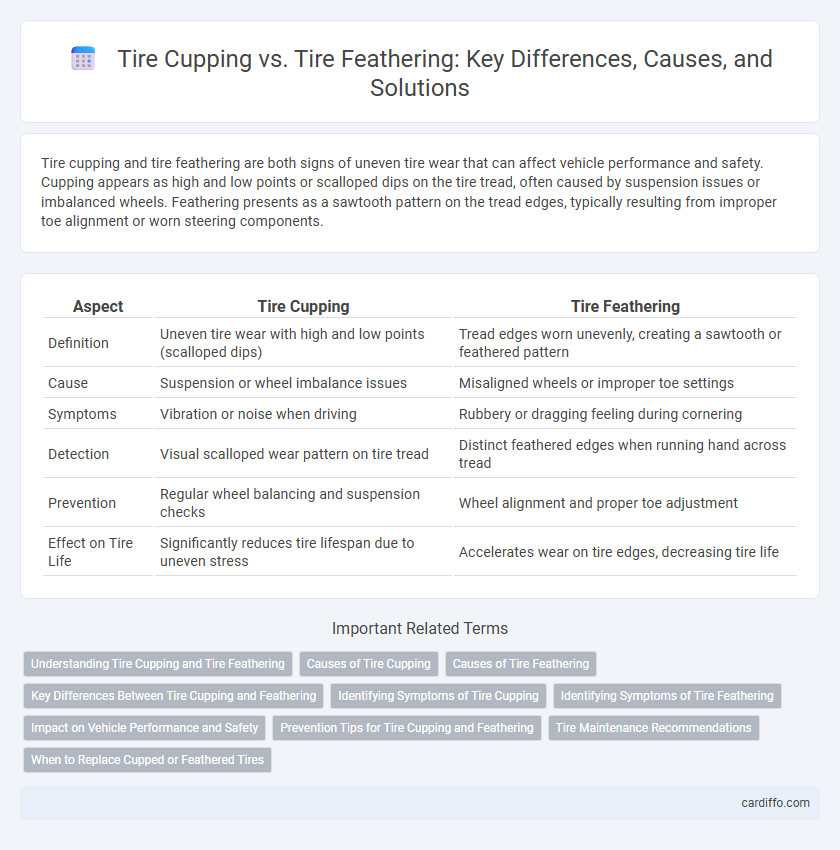Tire cupping and tire feathering are both signs of uneven tire wear that can affect vehicle performance and safety. Cupping appears as high and low points or scalloped dips on the tire tread, often caused by suspension issues or imbalanced wheels. Feathering presents as a sawtooth pattern on the tread edges, typically resulting from improper toe alignment or worn steering components.
Table of Comparison
| Aspect | Tire Cupping | Tire Feathering |
|---|---|---|
| Definition | Uneven tire wear with high and low points (scalloped dips) | Tread edges worn unevenly, creating a sawtooth or feathered pattern |
| Cause | Suspension or wheel imbalance issues | Misaligned wheels or improper toe settings |
| Symptoms | Vibration or noise when driving | Rubbery or dragging feeling during cornering |
| Detection | Visual scalloped wear pattern on tire tread | Distinct feathered edges when running hand across tread |
| Prevention | Regular wheel balancing and suspension checks | Wheel alignment and proper toe adjustment |
| Effect on Tire Life | Significantly reduces tire lifespan due to uneven stress | Accelerates wear on tire edges, decreasing tire life |
Understanding Tire Cupping and Tire Feathering
Tire cupping is characterized by uneven, scalloped wear patterns caused by suspension issues or imbalanced tires, leading to a bumpy ride and noise. Tire feathering refers to tread wear where tire edges become smooth on one side and sharp on the other due to misalignment, resulting in rubbing and reduced traction. Proper diagnosis of cupping and feathering is essential for timely suspension repairs and wheel alignment to extend tire lifespan and ensure vehicle safety.
Causes of Tire Cupping
Tire cupping is primarily caused by imbalanced tires, worn suspension components, or misaligned wheels that result in uneven tire contact with the road surface. This irregular contact leads to high and low spots on the tire tread, causing vibrations and a distinctive "cupped" wear pattern. Poor shock absorber performance can also contribute to tire cupping by allowing excessive tire movement during driving.
Causes of Tire Feathering
Tire feathering is primarily caused by worn or improperly adjusted suspension components, including misaligned tie rods and control arms that lead to uneven tire contact with the road. Poor wheel alignment, particularly incorrect toe settings, results in the tire's tread edges wearing unevenly, producing a feathered pattern that affects vehicle handling and increases noise. Regular suspension inspections and precise alignment corrections are essential to prevent the accelerated wear associated with tire feathering.
Key Differences Between Tire Cupping and Feathering
Tire cupping presents as uneven, high and low spots on the tread due to suspension or wheel balance issues, causing a bumpy ride and audible noise. Tire feathering features a saw-tooth or scalloped edge along the tread blocks, usually resulting from improper alignment, like incorrect toe settings, leading to uneven tire wear and reduced handling performance. Understanding these key differences helps diagnose suspension problems for cupping and alignment faults for feathering, ensuring timely maintenance and tire longevity.
Identifying Symptoms of Tire Cupping
Tire cupping presents as a series of high and low points or scalloped dips along the tire tread, often causing noticeable vibration or a rhythmic thumping sound while driving. This uneven wear pattern typically results from worn suspension components or imbalanced tires, leading to irregular tread contact with the road. Identifying these symptoms early can prevent further damage and improve vehicle handling and safety.
Identifying Symptoms of Tire Feathering
Tire feathering is characterized by a distinct, uneven wear pattern where the tread ribs develop sharp edges, often causing a noticeable rubbing noise during driving. Unlike tire cupping, which presents as rounded, scalloped dips, feathering manifests through gradual tilt or slant on the tread blocks, primarily resulting from misaligned suspension components or improper toe settings. Detecting feathering early involves inspecting tire edges for these sharp ridges and monitoring for vibration or noise indicative of alignment issues.
Impact on Vehicle Performance and Safety
Tire cupping causes uneven tread wear leading to vibrations and compromised ride comfort, while tire feathering results in uneven tread edges that reduce traction and increase tire noise. Both issues negatively affect vehicle stability, braking efficiency, and handling, increasing the risk of accidents. Addressing these problems promptly through proper alignment and suspension maintenance is crucial for maintaining optimal vehicle performance and safety.
Prevention Tips for Tire Cupping and Feathering
Prevent tire cupping and feathering by maintaining proper tire inflation and regularly rotating tires every 5,000 to 8,000 miles to ensure even wear. Inspect suspension components such as shocks, struts, and alignment to avoid uneven tire contact with the road surface. Balancing tires and addressing wheel misalignment promptly also reduces irregular tire wear patterns, enhancing tire lifespan and vehicle safety.
Tire Maintenance Recommendations
Tire cupping and tire feathering both indicate uneven tire wear caused by alignment and suspension issues. Regular tire rotation every 5,000 to 7,000 miles and periodic wheel alignment checks can prevent these wear patterns, ensuring even tire tread wear and extending tire lifespan. Maintaining proper tire pressure and inspecting suspension components during routine maintenance are essential steps to avoid premature tire damage and improve vehicle handling.
When to Replace Cupped or Feathered Tires
Tires with cupping exhibit irregular high and low spots on the tread, often causing vibrations and uneven contact with the road, signaling the need for immediate replacement to maintain safety and performance. Feathered tires show a sawtooth pattern on the edges, leading to noise and reduced traction, which requires replacement when the tread wear reaches the minimum legal limit or when handling deteriorates noticeably. Replacing tires with severe cupping or feathering prevents compromised vehicle stability, uneven tire wear progression, and potential blowouts on the road.
Tire cupping vs tire feathering Infographic

 cardiffo.com
cardiffo.com